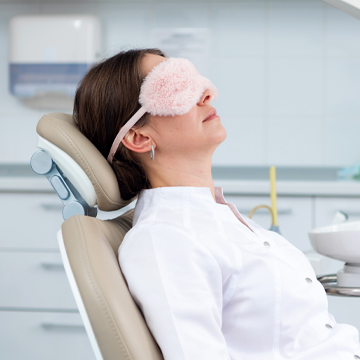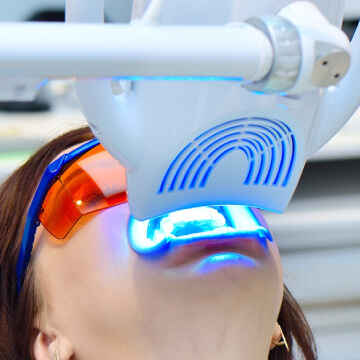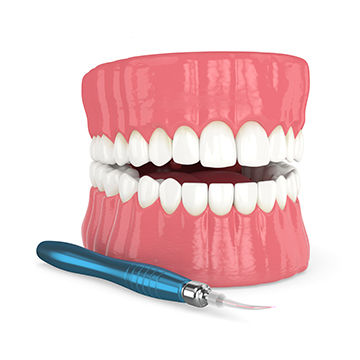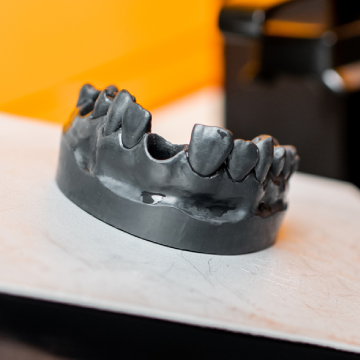Periodontal Treatment in Beverly Hills | Gum Specialist
Periodontitis is a serious gum infection you must treat to avoid damaged, loose, or lost teeth. While periodontitis is a common condition, it’s largely preventable through good oral hygiene practices, including brushing your teeth twice daily, flossing, and visiting the dentist regularly.
If you start experiencing gum disease symptoms and need periodontal treatment in Beverly Hills, Implant Dentistry by Doc Rok is here to restore your smile and the health of your gums.
Gum Disease Treatment and Symptoms
Periodontitis symptoms can encompass a wide range of symptoms, including the following:
- Bad breath
- Pain while chewing
- New spaces growing between your teeth
- Bleeding, tender, or swollen gums
- Purple or reddish gums
- Pus between your teeth
- Lost tooth
- Development of perio pockets
- Receding gums
If you experience any of these symptoms, you may need periodontal treatment, which includes surgical and nonsurgical options to improve the health of your teeth and gums.
Periodontal Care
There are several options for perio treatment, including gum grafting, dental implants, scaling and root planing, crown lengthening surgery, and periodontal plastic surgery.
One growing popular option is periodontitis laser treatment when impacted gum tissue is removed using lasers. In general, laser treatment is less invasive than traditional surgery. It can also reduce bleeding and potentially speed up your recovery time. If you’re interested in nonsurgical periodontal therapy, laser periodontal therapy might be a great option for you.
Periodontal Cleaning
Periodontal maintenance is different from typical teeth cleaning. It’s prescribed to treat periodontal disease and involves removing tartar from deep in the teeth and gums through scaling and root planing.
Your gum specialist might prescribe this perio treatment after you’ve been diagnosed with periodontal disease. In general, it’s recommended you get these kinds of cleanings every 3-4 months to maintain the health of your mouth.
Getting Periodontitis Treatment in Beverly Hills
Periodontitis treatment costs can vary depending on your needs, dental insurance, and the stage of the disease. In any case, our team at Implant Dentistry by Doc Rok can develop a treatment plan that accommodates your budget. Schedule a periodontal appointment with us today!
FAQs
Treatment of periodontal disease, an infection of the tissues supporting your teeth, involves a number of treatments. Scaling and root planing are two non-surgical treatments; flap surgery is one surgical alternative. Reducing inflammation, removing plaque and tartar, and restoring gum health are the aims. Effective periodontal treatment prevents further damage, reduces tooth loss risk, and promotes overall oral health by addressing the root causes of gum disease.
If you have red, swollen, or bleeding gums, chronic foul breath, receding gums, loose teeth, or pain while biting, you could require periodontal therapy. Untreated gum infection may cause tooth loss and other major health problems, hence early identification is essential. Regular dental check-ups help in identifying these signs early, ensuring timely intervention and effective management of periodontal disease.
Periodontal treatments include non-surgical and surgical options. Non-surgical treatments like scaling and root planing clean below the gum line to remove dental bacterial plaque and tartar. Surgical treatments, such as flap surgery, reduce pocket depth and regenerate lost bone and tissue. Laser therapy is also used for precise and less invasive treatment. These methods aim to eliminate infection, reduce inflammation, and restore healthy gum tissue, preventing further progression of gum disease.
When periodontal disease is early on, scaling and root planing work very well. By eliminating tartar and plaque below the gum line, this deep cleaning technique lowers irritation and bacterial burden. It promotes healing and reattachment of gum tissue to the teeth, improving periodontal health. Regular follow-up and good oral hygiene are essential to maintain the benefits of this treatment and prevent disease recurrence.
Yes, periodontal treatment can significantly prevent tooth loss by addressing the underlying gum disease that causes it. Treatments like scaling, root planing, and surgical interventions restore gum health and stabilize teeth. Success rates are high when gum disease is treated early, and maintenance through regular dental visits and proper oral hygiene is crucial. Periodontal treatment helps preserve the natural teeth and promotes overall oral health.
Laser therapy in periodontal treatment uses focused light energy to remove diseased tissue and bacteria from gum pockets. It is less invasive than traditional dental surgery, resulting in minimal bleeding and discomfort. Benefits include reduced healing time, less pain, and lower risk of infection. Laser therapy effectively targets specific areas, promoting faster recovery and improved gum health. It is a safe and efficient option for treating gum disease.
Periodontal treatments, while generally safe, can have risks and side effects. Non-surgical treatments like tooth scaling and root planing may cause temporary tooth sensitivity and gum discomfort. Surgical treatments carry risks such as infection, bleeding, and swelling. Laser therapy has fewer side effects but may still cause mild discomfort. Following your dentist's post-treatment care instructions and maintaining good oral hygiene can minimize these risks and promote healing.
Recovery from periodontal surgery typically takes about 1 to 2 weeks. During this time, you may experience mild discomfort, swelling, and sensitivity. It's important to follow your dentist's post-operative care instructions, which may include using prescribed medications, avoiding certain foods, and maintaining good oral hygiene. Regular follow-up visits ensure proper healing and address any concerns. Full recovery and stabilization of gums can take a few months.
Absolutely, periodontal therapy has the potential to greatly enhance foul breath (halitosis) resulting from gum disease. Treatments include as scaling and root planing effectively eliminate plaque, tartar, and germs located under the gum line, hence reducing the causes of bad breath. Enhancing gum health also improves overall oral health, hence decreasing the likelihood of tooth loss and associated issues. Ensuring proper oral hygiene and adhering to regular dentist appointments are crucial for long-lasting advantages and maintaining a pleasant breath.
To preserve gum health after periodontal therapy, it is crucial to adhere to rigorous oral hygiene routines, including brushing twice a day, flossing on a regular basis, and using antimicrobial mouthwash. Regular dental check-ups and professional teeth cleanings in Beverly Hills are essential for monitoring and preventing the reoccurrence of gum disease. Adopting a healthy diet, avoiding tobacco, and managing conditions like diabetes can also support gum health. Your dentist In Beverly Hills may recommend specific tools or techniques tailored to your needs.
Non-surgical options for treating periodontal disease include scaling and root planing, antibiotic treatments, and laser therapy. These methods are effective, particularly in the early stages of gum disease. Tooth scaling and root planing remove bacterial plaque and tartar below the gum line, reducing inflammation and promoting healing. Antibiotics target specific bacteria, while laser therapy offers a less invasive treatment with quicker recovery. These non-surgical treatments can effectively manage gum disease with proper maintenance.
Good oral hygiene is vital in preventing and managing periodontal disease. Regular brushing and flossing remove bacterial plaque and food particles that can cause gum inflammation and infection. Using an antiseptic mouthwash helps reduce bacteria in the mouth. Routine dental check-ups and cleanings ensure early detection and treatment of gum issues. Maintaining oral hygiene practices significantly reduces the risk of gum disease and supports overall oral health.
Yes, periodontal treatment can correct gum recession. Procedures such as gum grafting, where tissue is taken from another part of the oral environment or mouth or from a donor source and attached to the receded area, effectively cover exposed roots. Other methods include guided tissue regeneration and pinhole surgical techniques. These treatments restore the gum line, protect tooth roots, and improve aesthetics. Consulting with a periodontal specialist determines the best approach for your condition.
Signs of successful periodontal treatment include reduced gum inflammation, decreased pocket depth, and stabilization of loose teeth. Improved gum color and firmness also indicate healing. Ensuring long-term results involves maintaining excellent oral hygiene, regular dental check-ups, and cleanings. Following your dentist's recommendations for home care and addressing any risk factors, such as smoking or uncontrolled diabetes, also contribute to sustained periodontal health.
After periodontal treatment, it's essential to visit the dentist every 3 to 4 months for check-ups and cleanings. These regular visits help monitor gum health, remove plaque and tartar, and prevent disease recurrence. Your trusted local dentist will assess your progress and adjust your care plan as needed. Consistent follow-up appointments and diligent home care are crucial for maintaining the benefits of periodontal treatment and ensuring long-term oral health.
Recent advancements in periodontal treatment technology include laser therapy, minimally invasive surgical techniques, and regenerative materials. Laser therapy offers precise, less painful treatments with quicker recovery. Innovations like guided tissue regeneration use biocompatible materials to promote bone and tissue growth. Minimally invasive techniques reduce discomfort and healing time. These advancements improve treatment outcomes, patient comfort, and overall effectiveness in managing periodontal disease.
Periodontal disease can significantly affect overall health. It has been linked to systemic conditions like cardiovascular disease, diabetes, and respiratory infections. The inflammation caused by gum disease can enter the bloodstream, potentially contributing to heart disease and stroke. Managing periodontal disease through effective treatment and good oral hygiene not only improves oral health but also reduces the risk of these systemic health issues, promoting overall well-being.
Yes, periodontal treatment can be combined with other dental procedures like implants, crowns, and orthodontics. Treating gum disease ensures a healthy foundation for these treatments, improving their success rates. For example, healthy gums are essential for the stability of dental implants and the effectiveness of orthodontic treatment. Combining periodontal care with other procedures enhances overall oral health, functionality, and aesthetic outcomes, providing comprehensive dental care.
Expect a comprehensive examination, including X-rays, periodontal charting to determine pocket depths around your teeth, and a discussion of your medical and dental history, during your initial periodontal therapy appointment. Your gum health will be evaluated, any symptoms will be discussed, and any treatments will be explained by the Beverly Hills dentist. You will get a customized treatment plan that is catered to your requirements and includes the suggested treatments along with their advantages and related expenses. An efficient strategy for gum disease management is guaranteed by this thorough assessment.

























